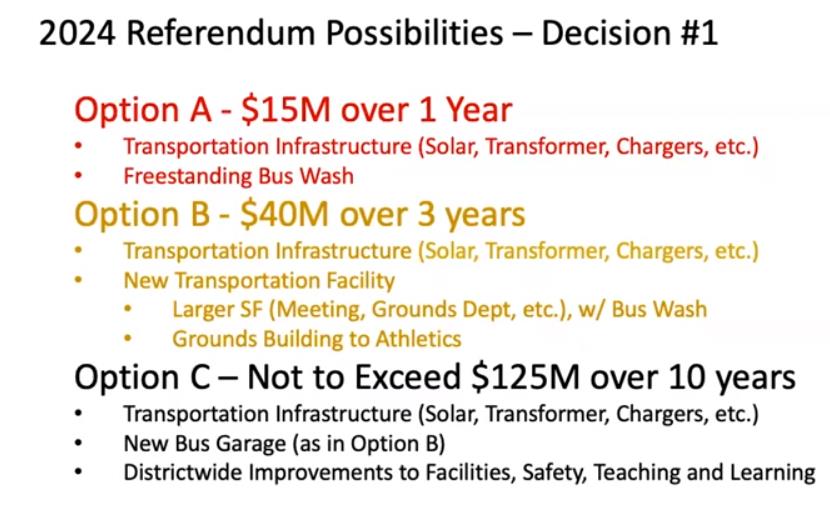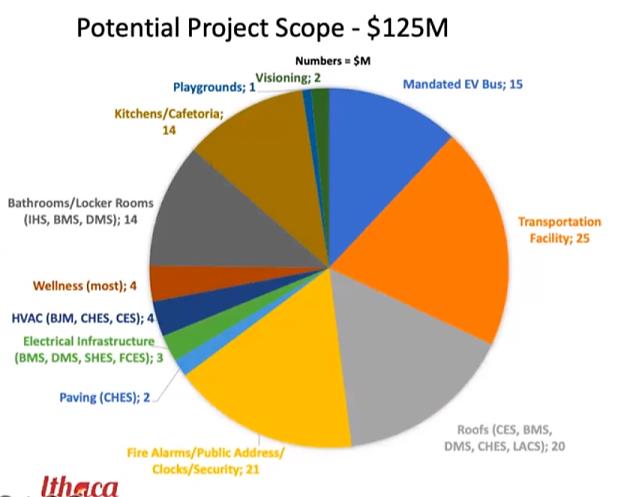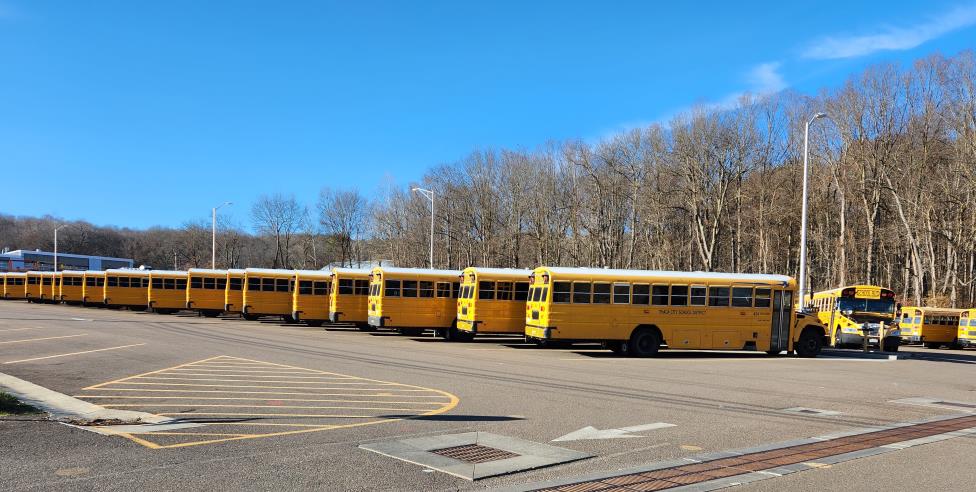Capital cornucopia could enter the nine figures
by Robert Lynch, November 26, 2023
It started with a handful of new electric buses and meeting their unique needs. But aspirations have grown quickly, and grown big. Based on a pair of Ithaca School Board meetings in mid-November, with plans likely to be finalized within the month, the Ithaca City School District stands ready to propose up to $125 Million in new capital spending. At minimum, the bond issue would bolster electrical charging capacity at the district’s transportation facility. At most, it would build a whole new maintenance garage and also undertake a still loosely-defined package of capital projects. It’s spending that, no doubt, a good many Ithaca tax dollars would someday need to replenish.

At a November 14th meeting of the Ithaca Board of Education—one that the local media chose to ignore—Board members heard a consultant lay out a range of capital investment options for the District. Two days later, at a committee meeting gaining even less public attention, those choices found themselves refined with Board member sentiment trending ever-more-solidly toward the most costly of the options. Replacement of the bus garage at the foot of Bostwick Road would become the key component in either of the two most likely alternatives to face voters.
“The bus garage is a little bit old, built in the 1960’s,” Christopher Glaubitz, Senior Project Manager for Tetra Tech consultants, told the School Board November 14th. “It’s been serving you very well for many, many, years,” he said. Yet in his mixed assessment, Glaubitz described the building’s infrastructure as “still serving you well, but aging.”
The School District’s bus garage was built in 1967 to service just 26 buses. It now must handle 88. Moreover, the anticipated electrification of the School District’s fleet—set by state mandate to be complete by 2035—will force heightened maintenance. And electric buses must also be kept clean. A new bus wash is part of each of the current capital alternatives. So is a major upgrade in electrical capacity to handle all of the new chargers. There’s a problem, however. The utility can’t deliver the required transformers for two more years.
But beyond what’s just been described, options depart. And they grow in cost exponentially. Glaubitz initially presented the School Board five choices. But by the time a joint committee work session had convened two nights later, those five had been narrowed to just three: 1) minimally upgrade the bus garage for electrification at $15 Million; 2) build a larger garage with space to merge the Grounds Department into it at $40 Million; or 3) think the big picture and bond $125 Million over a 10-year period. This third, larger option would fund a menagerie of things. It would build the garage, repair roofs, upgrade bathrooms and cafeterias, and even replace public address systems and clocks.

“$125 Million sounds like a lot of money,” Glaubitz admitted at the committee meeting. “It is a lot of money.” But then the consultant reminded Board members of the District’s 5,000 students to educate and more than one million square feet of space to maintain. “So, we’re talking a lot of large numbers,” regardless, he said.
“Yes, we should have our community thinking about the next capital projects if we want your Superintendent sitting in a meeting with others who have not thought that way and are freaking out,” Superintendent of Schools Dr. Luvelle Brown told the School Board during its meeting. “Because not thinking like the way we are,” Brown cautioned, could lead to increased taxes, forfeited opportunities for state aid, and “deferred maintenance where our roofs are leaking, and our spaces are antiquated, and we have entire facilities that were built in the 1960’s and have not expanded.”
Dr. Brown clearly favors the $125 Million, think-big choice. And it’s not like the Ithaca City School District hasn’t walked that path before. An earlier School Board proposed, and ICSD voters compliantly approved, a $120 Million capital program in 2019. Among other things, the 2019 spending paved the district’s sprawling school bus parking lot. Another $98 Million initiative, officials reminded the Facilities and Finance Committees November 16th, won similar approval in 2008.
State law requires any of the capital options to receive voter approval. Consultant Glaubitz said the District could either schedule a referendum to coincide with the annual School Board and Budget elections in May, or perhaps hold the vote later, next autumn. Amanda Verba, the Ithaca School District’s Chief Operating Officer, told the joint committee meeting she definitely favors a springtime vote.
“People really pay attention during budget season,” the District’s top fiscal administrator told the two committees. “So to educate them on a capital project, a referendum vote, that’s when people are tuning in.”
“There are other strategies to do a referendum at another time of the year,” Verba acknowledged. In Ithaca, “that’s not been our method because we really, truly believe in really capitalizing on that time when people are just thirsty for information about the School District.”

There may also be another strategy at play. Teachers and parents most predictably turnout for School Board and budget elections. And much of the envisioned capital spending would directly benefit those key constituencies. In political terms, it’s called vote banking.
If the School Board wants a springtime referendum, as most in charge seem to favor, its members will need to move quickly to finalize plans and settle on a preferred option. The consultant said that a May referendum would require Board action no later than December. The Ithaca School Board has voting meetings scheduled for November 28th and December 12th. The December date appears the more likely for the Board to act.
Any major capital initiative, including a new bus garage, would also need approval from the State of New York, its Education Department accustomed to micro-managing local capital spending. But once approved, bounty flows from Albany’s coffers. Glaubitz told Board members that state aid would fund 58.1 per cent of any capital expenditure. That fact makes capital investment a taxpayer bargain and encourages districts to bundle as much work as possible into capital packages. It costs the local taxpayer just 42 cents on the dollar to pay off a capital debt, as opposed to incurring the cost as a routine repair, Glaubitz explained.
Even though she leaned toward approving the $125 Million bonding outlay at the committees’ meeting November 16th, Board member Erin Croyle expressed real-world reservations.
“I would love to give all the money in the world to the School District, I just would” Croyle told colleagues. “I don’t want to take money away and not have capital improvement projects,” she submitted. “But I also know that it’s different now than it was in 2008, and people are hurting. Inflation is high and raises aren’t keeping up with it, and the tax burden hurts more than it has in a long time.”
“And so when we think about that, benefits to the students,” Croyle added, “what’s more beneficial; having certain things done at our schools, or having families have more money to buy shoes for school or rent equipment or musical instruments or lessons or all the things that enrich our students’ lives?”

Croyle asserted that even families on six-figure incomes struggle. Yet later in the same meeting, the Board member retreated a bit from her earlier reticence. She acknowledged that even a $125 Million bonding package may not prove sufficient to meet all the Ithaca District’s capital needs, and that still more spending might be required.
“It’s clear now that this is money that we need, regardless,” Croyle remarked, concluding it’s better to bond all at once, rather than to incur debt piecemeal. “This is just how we work. And so rather than doing it one year at a time and voting, we just want to do it for ten years. And hearing this now and hearing how much our buildings are aging, I actually am wondering, it does not exceed $125 Million, but what if we need to? (Do) we then have another referendum? How does that work?”
Erin Croyle serves as just one of nine members on the Ithaca Board of Education. But with the Superintendent on the side of nine-figure spending, and with only glancing concern having been voiced during Board member discussions on the 14th about fiscal overreach, odds are a $125 Million bond resolution will face Ithaca City School District voters next May.
Remember, this all started with the needs of electric buses and their impact on the Bostwick Road transportation facility. Last July and August, the first five electric buses arrived to join the ICSD fleet. Their purchase proved a relative bargain, as electric buses go. Operating Officer Verba advised the committees that electric vehicles cost a lot more; “upwards of $450,000” apiece, she said. That’s compared to about $175,000 for a diesel-powered bus. But the District mitigated its outlay this one time with a $200,000 rebate on each of five traditional vehicles traded in.

And if a new bus garage gets built, where would it go? It’ll most likely be on the same Bostwick Road site, east of the present building. It would occupy space where a couple of sheds set for demolition now stand. One Board member asked whether alternate sites had been studied. Glaubitz said he’d mention the (presumably dreaded) “D Word,” Danby. There’s ample space to build in that out-of-the-way locale; but still, he said, “it’s out there.” Guaubitz’s remark received no follow-up.
And another Green Energy option earned brief mention. Because of all the energy a full fleet of electric buses will draw from the grid, solar panels must sprout somewhere on the School District’s transportation facility site. Administrator Verba suggested a solar canopy could be built atop the buses parked in that recently-paved parking lot.
###

